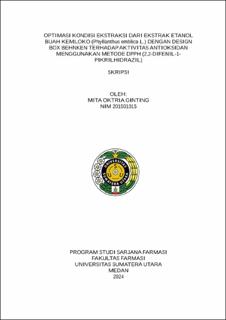Optimasi Kondisi Ekstraksi dari Ekstrak Etanol Buah Kemloko (Phyllanthus emblica L.) dengan Design Box Behnken terhadap Aktivitas Antioksidan Menggunakan Metode DPPH (2,2-Difenil-1-Pikrilhidrazil)
Optimization of Extraction Conditions from Kemloko Fruit (Phyllanthus emblica L.) Ethanol Extract with Behnken Box Design on Antioxidant Activity Using The DPPH (2,2-Diphenil-1-Picrylhydrazil) Method

Date
2024Author
Ginting, Mita Oktria
Advisor(s)
Syahputra, Hafid
Lubis, Muhammad Fauzan
Metadata
Show full item recordAbstract
Background: Kemloko fruit (Phyllanthus emblica L.) is a type of tropical plant that grows in Indonesia and contains secondary metabolites consisting of alkaloids, saponins and flavonoids which have high antioxidant properties. To produce optimal antioxidant activity, optimization is needed so that variations in the best extraction conditions are known using the Behnken Design Box. Research objectives: This research aims to determine the optimization process of kemloko fruit extraction using the Box Behnken Design. Research Method: This research uses the Microwave assisted extraction method with 96% ethanol to obtain a thick extract for determining single factors, making the extract using a Box Behnken Design with variations in power, ratio of ingredients and solvent and extraction time with the observed response namely yield and antioxidant activity using DPPH. Results: The results of the research show that the results of the characterization of simplicia meet the requirements, namely determining the water content of 6,67%, water soluble essence content of 41,63%, ethanol soluble essence content of 50,93%, total ash content of 3,51% and insoluble ash content acid 0,31%. The optimum yield and antioxidant activity values were obtained at a power of 450 watts, a material and solvent ratio of 1:20 and an extraction time of 14 minutes with a yield value of 51,29% and an IC50 value of 3,09 μg/mL. Conclusion: The best variation of extraction conditions was 450 watts of power, a material and solvent ratio of 1:20 g/mL and an extraction time of 14 minutes resulting in a yield of 51,29% and an antioxidant activity of 3,09 μg/mL.
Collections
- Undergraduate Theses [1719]
